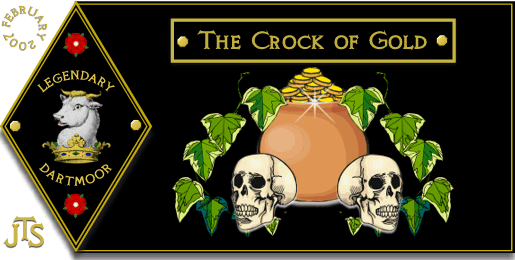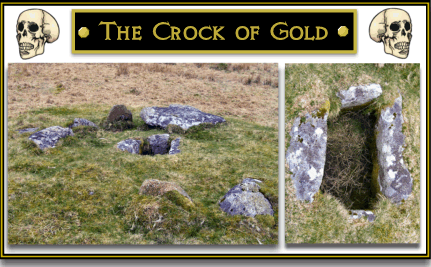
It was a cold November night and several moormen were huddled around the huge granite fireplace of the old inn. Outside the wind howled down from the high tors and rattled the old aging latch of the inn’s front door. The conversation had drifted from cattle prices to peat stacks when the assembled voices were lowered to a whisper as the topic of ancient gold was approached. This particular topic always included the story of old Luke Mudge and the ‘Crock of Gold’ and throughout its telling old heads would slowly shake in wissen judgement.
Luke Mudge once lived in a small cott perched precariously on the edge of Royal Hill from where he plied his trade as a net maker. From Monday to Friday he would sit making his nets which would then be touted around the nearby rabbit warrens on Saturday morning. Despite the fact that his workmanship was second to none the nets brought in very little coin and life for Luke was hard. Seldom would he be seen in the local inns and the roundsman called once a month to deliver his meagre supplies of candles and paraffin. Every Saturday his journey would take him passed the old ancients grave known locally as the Crock of Gold. Each time he would thoughtfully eye the grassy mound with its, “ring o’ stones”. Over the years he had heard the local stories of how the ancient’s graves often contained gold guineas which were the treasure hoard of a long dead chieftain. Luke had also heard the numerous tales of the evil curses that befell those daft enough to go in search of such riches. Luckily it was such stories that had prevented him from taking a bar ire or crowbar to the old tomb.
It must have been around April time that Luke accidentally spilt a pan full of boiling hot water over his hand. The pain and the blisters were bad enough but what even worse was the fact that he couldn’t sew his nets. No nets meant no money which then resulted in an empty dinner table and a grumbling stomach which cried out to be filled. Desperate situations call for drastic action and so one moonlit night in May saw Luke walking over to the Crock of Gold with his bar ire. After a quick scan of the hill Luke saw that nobody was abroad and so the heavy metal end of the ire was jammed into the heavy granite lid of the tomb. After several attempts the heavy lid was slid off and the gaping black hole of the grave yawned open. Luke’s heart began to thump in his chest as he gingerly lowered his hand down into the musty depths of the kist. In the darkness he felt around the peaty floor in search of the elusive guineas but all he could feel was small pieces of stone and broken pottery.
All of a sudden the moon disappeared behind a cloud that had scudded across from Bellever, the moor was plunged into pitch darkness. A blast of wind whipped up from the valley and a low moaning sound seemed to echo around the empty void of the grave. Luke heard the sound of granite dragging across granite then felt the excruciating pain shooting up from his right hand. Somehow the heavy granite lid had slid back over the kist trapping his right hand under its heavy mass.
It was the following morning when a passing miner spotted Luke lying beside the kist. Help was summoned and the old net maker was sprung from his granite trap. The poor fellow was barely alive and it took several weeks in hospital before he recovered. The upshot of his injuries were that his right hand was useless, just a withered stump of lifeless flesh. This effectively was his ticket to the Tavistock Workhouse as poor Luke was no longer able to sew his nets. It was a sad day when Luke Mudge trudged down to the town with a small bundle containing his meagre life possessions.
The local folk shook their heads, they knew this was no accident, this was the just rewards meted out by the ghosts of the ancients to anyone who defiled their graves.

The Crock of Gold is a good example of a Bronze Age kistvaen that has suffered at the hands of the tomb raiders. It is thought that the name refers to a tradition that whoever rifled through the grave found something of value. The kist clearly retains its four lining slabs and the capstone also remains nearby. There are five remaining stones insitu that would once have formed the retaining stone circle, Butler (1993, p. 230). Although on the small side for a Dartmoor kist, Worth, (1988, p.174), describes the Crock of Gold as being, “taken as a type of normal construction”. It can be assumed by the actual size of the kist that it contained a cremation as opposed to an inhumation.

Butler, J. 1993 Dartmoor Atlas of Antiquities – Vol. IV, Devon Books, Exeter.
Worth, R. N. 1988 Worth’s Dartmoor, David & Charles, Newton Abbot.
 Legendary Dartmoor The many aspects past and present of Dartmoor
Legendary Dartmoor The many aspects past and present of Dartmoor
